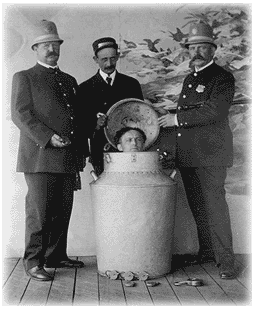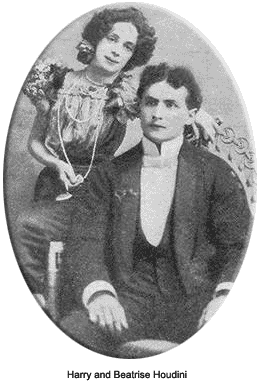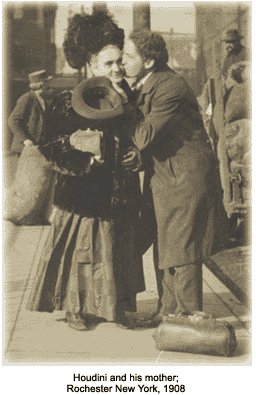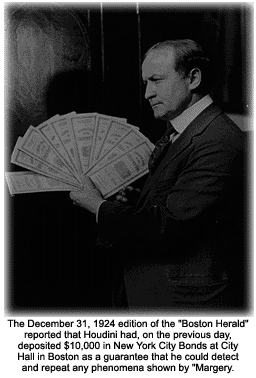Harry Houdini, born Ehrich Weiss on April 6, 1874, in Budapest, Hungary, was the son of Dr. Mayer Samuel Weiss, a Jewish rabbi, and Cecilia Steiner Weiss. He legally changed his name in 1913.
 Houdini is said to be one of the most influential magicians of the 20th century. His specialty was any type of escape, including slipping out of ropes, chains, and handcuffs while locked in trunks and milk cans, or submerged under water. Houdini became world famous by barnstorming across America and around the globe.
Houdini is said to be one of the most influential magicians of the 20th century. His specialty was any type of escape, including slipping out of ropes, chains, and handcuffs while locked in trunks and milk cans, or submerged under water. Houdini became world famous by barnstorming across America and around the globe.
Houdini had little formal education, but his self-education was a lifelong pursuit. "My mind," he is often quoted as saying, "is the key that sets me free."
Early Years
By the time Houdini was six, he had already developed a taste for magic and sleight of hand. His first trick was making a dried pea appear in any one of three cups. As a boy, he spent his time practicing acrobatics, and doing odd jobs as a newspaper seller and bootblack.
When Harry was nine, a circus arrived in town. He showed the manager his tricks and the man was so impressed with Harry`s talent for releasing himself from rope ties, and picking up pins with his eyelids, that he hired him to perform while the circus was in town.
At age 11, Houdini began to work for a local locksmith and was soon able to pick any lock. After reading a memoir by the famous French magician, Houdin, Houdini decided to follow him career-wise. With a friend named Hayman, he started the Houdini Brothers, named after the Frenchman.
 Houdini's Magic & Illusions Legacy
Houdini's Magic & Illusions Legacy
When Hayman and Harry parted ways, Harry`s brother Theodore became his partner. Initially, Harry`s magic career met with little success, but in 1893 at the age of 19, he met fellow performer Wilhelmina Beatrice (Bess) and married her after a three-week courtship. After Houdini taught her the principles of conjuring and mind reading, Bess worked as his stage assistant for the rest of his performing career.
Houdini initially focused on cards and other traditional card acts. At one point, he billed himself as the "King of Cards." One of his most notable non-escape stage illusions was performed in 1918 on the brightly lit stage of the Hippodrome in New York City. There Houdini made a 10,000-pound elephant disappear. When Houdini fired a pistol, Jennie the Elephant vanished from view, and the crowd went wild.
Houdini soon began to experiment more with escape acts. His big break came in 1899, when he met showman Martin Beck. Impressed by Houdini`s handcuff act, Beck advised him to concentrate on escape acts and booked him on the Orpheum Vaudeville circuit.
Within months, Houdini was performing at the top vaudeville houses in the country. In 1900, he traveled to Europe to perform. By the time he returned in 1904, he had become a sensation.
Between the years of 1904 and 1920, Houdini performed all over the U.S. with great success. In 1913, he introduced perhaps his most famous act of all, the Chinese Water Torture Cell, in which he was suspended upside-down in a locked glass and steel cabinet filled to the top with water.
Many of his escapes were originally performed behind curtains, with him popping out free at the end. However, Houdini discovered that audiences were more impressed and entertained when the curtains were eliminated, so that they could watch him struggle to get out. On more than one occasion, he performed his straitjacket escape dangling upside-down from the roof of a building for increased dramatic effect, and to the utter thrill of the spectators.
 In 1919, Houdini signed a contract with film producer B.A. Rolfe, to star in his 15-part serial, "The Master Mystery." However, financial difficulties resulted in Rolfe`s going out of business. Houdini was then signed by Famous Players-Lasky Corporation, for whom he made two pictures before establishing his own film-production company.
In 1919, Houdini signed a contract with film producer B.A. Rolfe, to star in his 15-part serial, "The Master Mystery." However, financial difficulties resulted in Rolfe`s going out of business. Houdini was then signed by Famous Players-Lasky Corporation, for whom he made two pictures before establishing his own film-production company.
Called the "Houdini Picture Corporation," he produced and starred in three films. Although success in film eluded him, and he gave up on the business in 1923, his fame became so widespread that years later, he was given a star on the Hollywood Walk of Fame.
In the 1920s, following the death of his much-loved mother, Houdini turned his energies toward debunking self-proclaimed psychics and mediums. Houdini`s magic training allowed him to expose frauds that had successfully fooled many scientists and laymen.
 Houdini was a member of a "Scientific American" committee that offered a cash prize to any medium who could successfully demonstrate supernatural abilities. Thanks to Houdini`s efforts, the prize was never collected.
Houdini was a member of a "Scientific American" committee that offered a cash prize to any medium who could successfully demonstrate supernatural abilities. Thanks to Houdini`s efforts, the prize was never collected.
Houdini began to attend séances in disguise, accompanied by a reporter and police officer. Possibly the most famous medium that he debunked was the Boston spiritualist Mina Crandon, also known as "Margery."
Houdini in Death
Houdini died on October 31, 1926, at the age of 52. He died of peritonitis from a ruptured appendix when he had sustained a surprise blow to his abdomen from boxing student J. Gordon Whitehead in Montreal two weeks earlier. It was a long-standing part of Houdini`s act to deflect such blows. But Houdini was reclining on his couch after his performance, in this instance, and was struck several times, with no chance to prepare himself.
Despite popular belief, it was the appendicitis and not the blow that was the cause of his death, although it is thought that the pain inflicted by the blows may have masked the pain of the appendicitis, which prevented Houdini from seeking treatment.
Houdini`s funeral was held on November 4, 1926, in New York, with more than 2,000 mourners in attendance. His remains were buried in the Machpelah Cemetery, Queens, New York, with the crest of the Society of American Magicians inscribed on the gravesite. The society holds their "Broken Wand" ceremony at the gravesite on the anniversary of his death to this day.
Shortly before his death, Houdini had made a pact with his wife to contact her from the other side if possible and deliver a pre-arranged coded message. Every Halloween for the next 10 years, Bess held a séance in an effort to contact her husband.
In 1936, after a final unsuccessful séance on the roof of the Knickerbokker Hotel, she put out the candle that she had kept burning beside a photo of Houdini since his death. She was later quoted as saying, "Ten years is long enough to wait for any man."